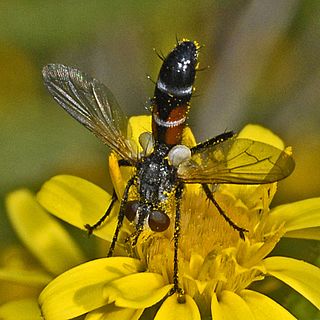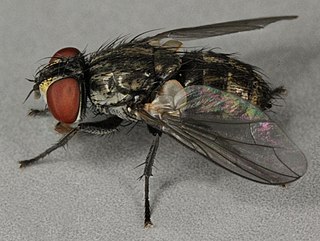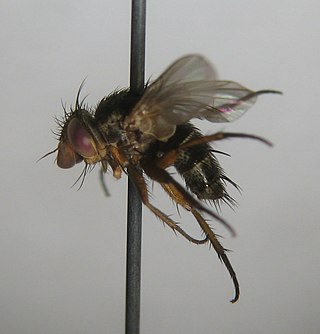
The Tachinidae are a large and variable family of true flies within the insect order Diptera, with more than 8,200 known species and many more to be discovered. Over 1,300 species have been described in North America alone. Insects in this family commonly are called tachinid flies or simply tachinids. As far as is known, they all are protelean parasitoids, or occasionally parasites, of arthropods, usually other insects. The family is known from many habitats in all zoogeographical regions and is especially diverse in South America.

Phasia hemiptera is a fly belonging to the family Tachinidae.

Blepharomyia is a genus of flies in the family Tachinidae.

Catharosia is a genus of flies in the family Tachinidae.
Litophasia is a genus of flies in the family Tachinidae.

Tachina fera is a species of fly in the genus Tachina of the family Tachinidae. It was first described by Carl Linnaeus in 1761.

Compsilura concinnata is a parasitoid native to Europe that was introduced to North America in 1906 to control invasive populations of the exotic gypsy moth , which primarily infests forests. The fly is an endoparasitoid of insect larvae that lives within its host for most of its life. The parasitoid eventually kills the host and occasionally eats it. It attacks over 200 host species, mainly insects from the orders Coleoptera, Lepidoptera, and Hymenoptera.

Cylindromyia interrupta is a species of fly in the family Tachinidae.

Cylindromyia brassicaria is a species of fly in the family Tachinidae.
Clytiomya continua is a European species of fly in the family Tachinidae. Hosts for the parasitoid larvae include Coreus marginatus orientalis, Eurygaster testudinaria, Eurydema gebleri, Eurydema dominulus, Graphosoma rubrolineatum, Homalogonia confusa, and Dolycoris baccarum. Larval development takes six to eleven days.
Loewia submetallica is a European species of fly in the family Tachinidae.

Zophomyia temula is a species of fly in the family Tachinidae.

Phytomyptera cingulata is a European species of fly in the family Tachinidae.
Bithia modesta is a species of bristle fly in the family Tachinidae.
Micronychia ruficauda is a European species of fly in the family Tachinidae.

Dexiosoma caninum is a European species of fly in the family Tachinidae. In the United Kingdom, the species can most commonly be found during the summer in the south of England.

Nemoraea pellucida is a species of fly in the family Tachinidae.

Siphona (Aphantorhaphopsis) verralli is a Palearctic species of fly in the family Tachinidae.
Siphona (Ceranthia) abdominalis is a tachinid fly in the subgenus Ceranthia of the family Tachinidae. The species was first described by Jean-Baptiste Robineau-Desvoidy in 1830.

Nemorilla floralis is a species of tachinid fly.
















